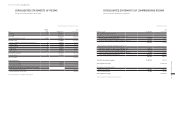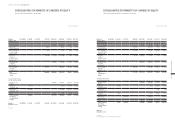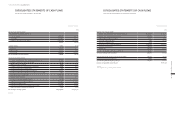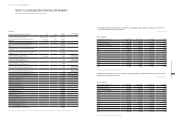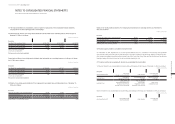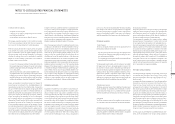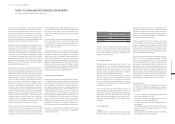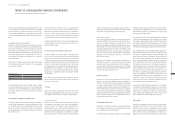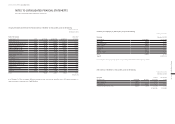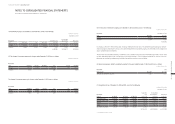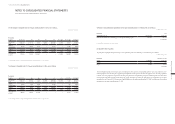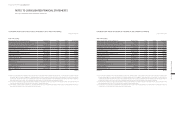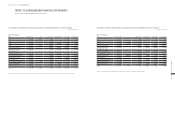Hyundai 2014 Annual Report Download - page 51
Download and view the complete annual report
Please find page 51 of the 2014 Hyundai annual report below. You can navigate through the pages in the report by either clicking on the pages listed below, or by using the keyword search tool below to find specific information within the annual report.
HYUNDAI MOTOR COMPANY Annual Report 2014
FINANCIAL STATEMENTS / 101100
share of losses of an associate or a joint venture exceeds the
Group’s interest in that associate or joint venture (which in-
cludes any long-term interests that, in substance, form part of
the Group’s net investment in the associate or the joint ven-
ture), the Group discontinues recognizing its share of further
losses. Additional losses are recognized only to the extent that
the Group has incurred legal or constructive obligations or made
payments on behalf of the associate or the joint venture.
Any excess of the cost of acquisition over the Group’s share of
the net fair value of the identifiable assets, liabilities and con-
tingent liabilities of an associate or a joint venture recognized
at the date of acquisition is recognized as goodwill, which is in-
cluded within the carrying amount of the investment. The entire
carrying amount of the investment including goodwill is tested
for impairment and presented at the amount less accumulated
impairment losses. Any excess of the Group’s share of the net
fair value of the identifiable assets, liabilities and contingent
liabilities over the cost of acquisition, after reassessment, is
recognized immediately in profit or loss.
Upon disposal of an associate or a joint venture that results in
the Group losing significant influence over that associate or joint
venture, any retained investment is measured at fair value at that
date and the fair value is regarded as its fair value on initial rec-
ognition as a financial asset in accordance with K-IFRS 1039. The
difference between the previous carrying amount of the asso-
ciate or joint venture attributable to the retained interest and its
fair value is included in the determination of the gain or loss on
disposal of the associate or joint venture. In addition, the Group
accounts for all amounts previously recognized in other com-
prehensive income in relation to that associate or joint venture
on the same basis we would be required if that associate or joint
venture had directly disposed of the related assets or liabilities.
Therefore, if a gain or loss previously recognized in other com-
prehensive income by that associate or joint venture would be
reclassified to profit or loss on the disposal of the related assets
or liabilities, the Group reclassifies the gain or loss from equity
to profit or loss (as reclassification adjustment) when it loses
significant influence over that associate or joint venture.
When the Group reduces its ownership interest in an associate
or a joint venture but the Group continues to use the equity
method, the Group reclassifies to profit or loss the proportion
of the gain or loss that had previously been recognized in other
comprehensive income relating to that reduction in ownership
interest if that gain or loss would be reclassified to profit or loss
on the disposal of the related assets or liabilities. In addition, the
Group applies K-IFRS 1105 to a portion of investment in an as-
sociate or a joint venture that meets the criteria to be classified
as held for sale.
The Group continues to use the equity method when an invest-
ment in an associate becomes an investment in a joint venture
or an investment in a joint venture becomes an investment in an
associate. There is no remeasurement to fair value upon such
changes in ownership interests.
Unrealized gains from transactions between the Group and its
associates or joint ventures are eliminated up to the shares in
associate (joint venture) stocks. Unrealized losses are also elim-
inated unless evidence of impairment in assets transferred is
produced. If the accounting policy of associates or joint ventures
differs from the Group, financial statements are adjusted accord-
ingly before applying equity method of accounting. If the Group’s
ownership interest in an associate or a joint venture is reduced,
but the significant influence is continued, the Group reclassifies
to profit or loss only a proportionate amount of the gain or loss
previously recognized in other comprehensive income.
(12) Property, plant and equipment
Property, plant and equipment is to be recognized if, and only if
it is probable that future economic benefits associated with the
asset will flow to the Group, and the cost of the asset can be
measured reliably. After the initial recognition, property, plant
and equipment is stated at cost less accumulated depreciation
and accumulated impairment losses. The cost includes any cost
directly attributable to bringing the asset to the location and
condition necessary for it to be capable of operating in the
manner intended by management and the initial estimate of the
costs of dismantling and removing the item and restoring the
site on which it is located. In addition, in case the recognition
criteria are met, the subsequent costs will be added to the car-
rying amount of the asset or recognized as a separate asset,
and the carrying amount of what was replaced is derecognized.
Depreciation is computed using the straight-line method based
on the estimated useful lives of the assets. The representative
useful lives are as follows:
Representative useful lives (years)
Buildings and structures 2 - 50
Machinery and equipment 2 - 25
Vehicles 3 - 20
Dies, molds and tools 2 - 15
Office equipment 2 - 20
Other 2 - 30
The Group reviews the depreciation method, the estimated use-
ful lives and residual values of property, plant and equipment at
the end of each annual reporting period. If expectations differ
from previous estimates, the changes are accounted for as a
change in accounting estimate.
(13) Investment property
Investment property is property held to earn rentals or for cap-
ital appreciation or both. An investment property is measured
initially at its cost and transaction costs are included in the
initial measurement. After initial recognition, the book value of
investment property is presented at the cost less accumulated
depreciation and accumulated impairment losses.
Subsequent costs are recognized as the carrying amount of the
asset when, and only when it is probable that future economic
benefits associated with the asset will flow to the Group, and
the cost of the asset can be measured reliably, or recognized
as a separate asset if appropriate. The carrying amount of what
was replaced is derecognized.
Land is not depreciated, and other investment properties are
depreciated using the straight-line method over the period from
20 to 50 years. The Group reviews the depreciation method, the
estimated useful lives and residual values at the end of each
annual reporting period. If expectations differ from previous es-
timates, the changes are accounted for as a change in account-
ing estimate.
(14) Intangible assets
1) Goodwill
Goodwill arising from a business combination is recognized as
an asset at the time of obtaining control (the acquisition-date).
Goodwill is measured as the excess of the aggregate of the
consideration transferred, the amount of any non-controlling
interest in the acquiree, and the acquisition-date fair value of
the Group’s previously held equity interest in the acquiree over
the net of the acquisition-date amounts of the identifiable as-
sets acquired and the liabilities assumed.
If, after reassessment, the net of the acquisition-date amounts
of the identifiable assets acquired and the liabilities assumed
exceeds the aggregate of the consideration transferred, the
amount of any non-controlling interest in the acquiree, and the
acquisition-date fair value of the Group’s previously held equity
interest in the acquiree, the excess is recognized immediately in
profit or loss as a bargain purchase gain.
Goodwill is not amortized but tested for impairment at least an-
nually. For purposes of impairment tests, goodwill is allocated
to those cash generating units (“CGU”) of the Group expected
to have synergy effect from the business combination. CGU
that goodwill has been allocated is tested for impairment every
year or when an event occurs that indicates impairment. If re-
coverable amount of a CGU is less than its carrying amount, the
impairment will first decrease the goodwill allocated to that CGU
and the remaining impairment will be allocated among other
assets relative to its carrying value. Impairment recognized for
goodwill may not be reversed. When disposing a subsidiary, re-
lated goodwill will be included in gain or loss from disposal.
2) Development costs
The expenditure on research is recognized as an expense when
it is incurred. The expenditure on development is recognized
as an intangible asset if, and only if, all of the following can be
demonstrated:
■ the technical feasibility of completing the intangible asset so
that it will be available for use or sale;
■ the intention to complete the intangible asset and use or sell it;
■ the ability to use or sell the intangible asset;
■ how the intangible asset will generate probable future eco-
nomic benefits;
■ the availability of adequate technical, financial and other re-
sources to complete the development and to use or sell the
intangible asset; and
■ the ability to measure reliably the expenditure attributable to
the intangible asset during its development.
NOTES TO CONSOLIDATED FINANCIAL STATEMENTS
AS OF AND FOR THE YEARS ENDED DECEMBER 31, 2014 AND 2013


